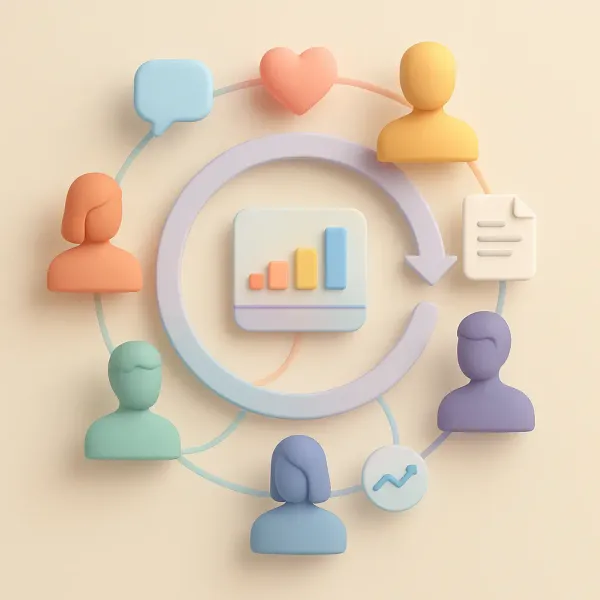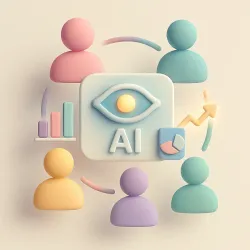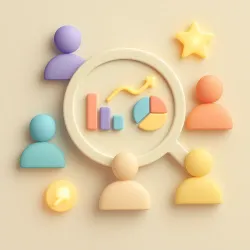Employee experience has evolved from a corporate buzzword to a fundamental business imperative. As we navigate 2026, organizations face unprecedented challenges: global engagement has fallen to 21%, matching pandemic-era lows, while 51% of employees are actively exploring new opportunities (Gallup, 2025). The message is clear—how employees experience work isn't just an HR concern; it's a critical driver of organizational performance, innovation, and competitive advantage.
Understanding Employee Experience: The Foundation
Employee experience (EX) encompasses the sum total of every interaction an employee has with their organization throughout their entire journey—from the first impression during recruitment to their final day and beyond. It's the cumulative perception formed at every touchpoint, shaped by workplace culture, technology, leadership, physical environment, and the quality of relationships within the organization.
Unlike employee engagement, which focuses on emotional commitment and motivation, employee experience takes a holistic view. It examines the entire ecosystem that influences how employees feel about their work and workplace. As research shows, employees who report positive experiences are 16 times more engaged than those with negative experiences (McKinsey, 2024).
The business case for prioritizing employee experience is compelling. Organizations in the top 25% for employee experience report 2x return on sales and nearly 3x return on assets compared to their peers (IBM Smarter Workforce Institute, 2024). Conversely, disengaged employees cost companies between $450-$550 billion annually in lost productivity (Gallup, 2024).
The Employee Experience Journey: Key Touchpoints
Employee experience unfolds across distinct stages, each containing critical touchpoints that shape perception and engagement:
1. Pre-Hire and Recruitment
The employee experience begins before day one. From job postings to interview processes, candidates form lasting impressions. Clear communication, transparent salary expectations, and respectful hiring practices set the foundation for trust. Organizations that deliver positive candidate experiences see higher acceptance rates and stronger employer branding.
2. Onboarding and Integration
First impressions matter enormously. Research reveals that only 12% of employees believe their company excels at onboarding (Gallup, 2024). Effective onboarding goes beyond paperwork—it creates belonging, clarifies purpose, and accelerates time to productivity. The first 90 days are particularly critical for retention and long-term engagement.
3. Daily Experience and Culture
The everyday reality of work—team dynamics, manager relationships, autonomy, and psychological safety—shapes the bulk of employee experience. Managers account for 70% of variance in employee engagement (Gallup, 2024), making the quality of leadership the single most influential factor in how employees experience work.
4. Development and Growth
Opportunities for learning, skill development, and career advancement are fundamental to positive employee experience. Organizations must move beyond one-size-fits-all training to create personalized learning pathways that align with individual aspirations and organizational needs.
5. Recognition and Rewards
Recognition profoundly impacts employee motivation and retention. When employees feel genuinely valued for their contributions, they're more likely to remain engaged and committed. Effective recognition programs align with company values and occur frequently, not just during annual reviews.
6. Transitions and Life Events
Promotions, team changes, personal milestones, and challenges are "moments that matter" with disproportionate impact on employee experience. How organizations support employees during these transitions signals their values and commitment to people.
7. Offboarding and Alumni Relations
The employee experience doesn't end at resignation. Thoughtful exit processes provide valuable feedback, maintain positive relationships, and protect employer brand reputation.
2026 Employee Experience Trends: What's Changing
1. The Manager Crisis Requires Urgent Action
The most alarming trend in 2026 is the collapse in manager engagement. Manager engagement dropped from 30% to 27% in just one year, with young managers (under 35) and female managers experiencing the sharpest declines—5 and 7 percentage points respectively (Gallup, 2025).
This matters because manager engagement directly influences team performance and organizational productivity. Organizations must prioritize manager development and ensure managers have the resources, training, and support needed to lead effectively in today's complex work environment.
Strategy: Invest in comprehensive manager training that builds coaching skills, emotional intelligence, and the ability to create psychological safety. Reduce manager span of control to ensure adequate attention for direct reports.
2. AI Integration: From Threat to Tool
45% of workers already use AI tools weekly, and 80% of daily users believe AI will increase their efficiency (Future of Work Report, 2025). Yet only one-third of HR leaders are actively exploring AI's potential for improving employee experience.
The hesitation stems from valid concerns about job displacement and ethics. However, forward-thinking organizations are using AI to predict burnout, personalize learning journeys, optimize workflows, and free employees for higher-value creative and strategic work.
Strategy: Move beyond fear to strategic AI adoption. Use AI to enhance—not replace—human capabilities. Focus on tools that reduce administrative burden, provide real-time insights into employee sentiment, and enable more personalized employee experiences.
3. Trust and Benevolence: The New Leadership Mandate
While 68% of employees view their leaders as competent and 67% believe their behavior aligns with organizational values, only 56% feel their leaders will act with benevolence (Qualtrics, 2025). This trust gap threatens engagement and performance.
Employees are watching whether leaders prioritize people or profit during difficult decisions. Benevolence—demonstrating genuine care for employee wellbeing—has become the differentiating factor in leadership effectiveness.
Strategy: Leaders must demonstrate benevolence through actions, not just words. Implement transparent communication, involve employees in decisions that affect them, and show that employee wellbeing is a genuine priority, not a performative gesture.
4. The Hybrid Work Reality
83% of workers prefer hybrid models, valuing flexibility to choose where they work (Future of Work Report, 2025). Yet some organizations are mandating full returns to office, betting on in-person collaboration to drive innovation.
The data suggests a middle path: hybrid work is here to stay, but it requires intentional design. Organizations must rethink how they communicate, build culture, and create equitable experiences for both remote and on-site employees.
Strategy: Design hybrid policies around outcomes, not presence. Invest in digital infrastructure that enables seamless communication and collaboration. Create intentional opportunities for in-person connection during moments that truly benefit from face-to-face interaction.
5. The Digital Employee Experience (DEX) Gap
46% of employees are dissatisfied with their workplace applications (Gallup, 2024). Poor technology experiences create daily frustration, reduce productivity, and contribute to disengagement.
Organizations must ensure that digital tools mirror the seamless experiences employees have in their personal lives. Integration through HRIS systems, mobile accessibility, and user-friendly interfaces are no longer optional—they're essential components of positive employee experience.
Strategy: Audit your digital employee experience regularly. Ensure tools are intuitive, integrated, and accessible to all employees, including frontline workers. Invest in platforms like Happily.ai that consolidate feedback, recognition, and engagement measurement in one seamless experience.
6. Purpose-Driven Work and ESG Alignment
Employees increasingly seek work that aligns with their values. Organizations that integrate ESG (Environmental, Social, and Governance) efforts with employee experience attract talent that shares their values and build cultures that thrive on impact.
Purpose is no longer a bonus—it's a business strategy. When employees understand how their work contributes to meaningful outcomes, engagement and commitment naturally follow.
Strategy: Articulate your organization's purpose clearly and demonstrate how individual roles contribute to it. Align company values with authentic ESG commitments that employees can see and participate in.
7. Continuous Listening and Real-Time Action
Annual engagement surveys are insufficient for understanding dynamic employee sentiment. Organizations are shifting to continuous feedback mechanisms that provide real-time insights into employee experience.
Pulse surveys, always-on feedback channels, and behavioral analytics enable organizations to identify and address issues before they escalate to turnover.
Strategy: Implement continuous listening strategies that capture employee sentiment at key touchpoints. More importantly, act on the feedback quickly and communicate what actions you're taking. Employees need to see that their voices lead to tangible improvements.
Building an Employee Experience Strategy for 2026
Creating a comprehensive employee experience strategy requires intentional design across multiple dimensions:
1. Start with Employee Journey Mapping
Map every stage of the employee lifecycle to identify critical touchpoints, pain points, and opportunities. Segment by employee personas—new graduates experience work differently than mid-career professionals or people managers.
Layer real-time sentiment data over each touchpoint to understand how perceptions evolve. This approach reveals patterns that inform targeted interventions.
2. Measure What Matters
Track leading indicators that predict engagement and retention:
- eNPS (Employee Net Promoter Score): Measures likelihood to recommend your organization
- Sentiment scores: Track how employees feel about key aspects of work
- Participation rates: Monitor engagement in feedback, recognition, and development programs
- Manager effectiveness: Regular 360-degree feedback on leadership quality
- Time to productivity: How quickly new hires become fully effective
3. Close the Feedback Loop
Collecting feedback without action breeds cynicism. Establish clear processes for analyzing feedback, prioritizing improvements, and communicating progress to employees. Transparency builds trust and demonstrates that employee voices matter.
4. Empower Managers
Since managers account for 70% of engagement variance, investing in manager effectiveness is the highest-leverage intervention available. Provide managers with:
- Training in coaching, feedback, and emotional intelligence
- Time and resources to support their teams effectively
- Real-time insights into team sentiment and wellbeing
- Clear expectations and accountability for team engagement
5. Design for Inclusion and Belonging
Diversity without inclusion creates disappointing experiences. Organizations must ensure that all employees—regardless of background, role, or location—have equitable access to opportunities, resources, and support.
Culture fit versus culture add thinking helps build diverse teams while maintaining shared values. Focus on values alignment rather than demographic similarity.
6. Leverage Technology Thoughtfully
The right technology amplifies employee experience initiatives. Platforms like Happily.ai integrate multiple aspects of employee experience—pulse surveys, recognition programs, real-time analytics, and performance management—into cohesive, user-friendly systems.
Technology should reduce friction, not create it. Choose solutions that employees actually want to use and that provide actionable insights for leaders.
7. Create a Culture of Recognition
Recognition is one of the highest-impact, lowest-cost interventions available. When employees feel genuinely appreciated, they're more engaged, productive, and loyal.
Build recognition into daily workflows through peer-to-peer appreciation, manager acknowledgment, and milestone celebrations. Ensure recognition is frequent, specific, and aligned with organizational values.
The ROI of Employee Experience
Investing in employee experience delivers measurable returns:
- Productivity: Engaged teams are 21% more productive (Gallup, 2024)
- Retention: Organizations with positive EX see 59% lower turnover (Gallup, 2024)
- Customer satisfaction: Companies with high EX maturity report 30% higher Net Promoter Scores (PwC, 2024)
- Financial performance: EX leaders see 23% higher profit than bottom-quartile organizations (Gallup, 2024)
- Innovation: Engaged employees drive higher rates of innovation and organizational citizenship
The global cost of disengagement—$8.8 trillion annually, accounting for 9% of global GDP (Gallup, 2023)—makes the opportunity cost of inaction staggering.
Looking Ahead: The Future of Employee Experience
As we navigate 2026, several realities are becoming clear:
- Employee experience is experience design: The best organizations approach EX with the same rigor they apply to product development and customer experience.
- Culture shows up in speed: How quickly organizations make decisions, respond to feedback, and adapt to change directly reflects their culture quality. Culture shows up as latency.
- The relationship infrastructure matters more than individual traits: Success depends less on hiring perfect individuals and more on building strong relationship networks that enable collaboration and support.
- People-first organizations will win: As AI handles more routine tasks, uniquely human capabilities—creativity, empathy, strategic thinking, and relationship-building—become the primary source of competitive advantage.
- Continuous evolution is essential: Employee expectations continue to evolve rapidly. Organizations must maintain agility, continuously listen, and adapt their approaches based on changing needs.
Taking Action: Your Next Steps
Improving employee experience doesn't require perfection—it requires commitment to progress. Here's how to begin:
- Assess your current state: Conduct a comprehensive audit of employee sentiment across the entire journey using tools like employee engagement surveys.
- Identify quick wins: Find high-impact, low-effort improvements that signal your commitment to change—perhaps improving onboarding, implementing peer recognition, or increasing manager one-on-one frequency.
- Build the business case: Quantify the costs of disengagement and potential returns from improvement using metrics and analytics.
- Invest in enabling technology: Choose platforms that integrate multiple aspects of employee experience and provide real-time insights. Explore solutions like Happily.ai that combine measurement, recognition, and action planning.
- Create accountability: Assign clear ownership for employee experience initiatives and track progress through regular reporting to leadership.
- Start listening and acting: Implement continuous feedback mechanisms and commit to acting on what you hear.
Conclusion
Employee experience in 2026 isn't about choosing between people and performance—it's recognizing that people are performance. Organizations that design intentional, human-centered experiences throughout the employee journey will attract better talent, build more resilient teams, and create competitive advantages that are difficult to replicate.
The challenges are real: falling engagement, trust gaps, manager burnout, and rapid technological change. But these challenges also present opportunities for organizations willing to prioritize authentic, meaningful employee experiences.
The question isn't whether to invest in employee experience—it's whether you can afford not to. The organizations leading in 2026 and beyond will be those that understand employee experience isn't a program or initiative. It's the essence of how work gets done, how people feel every day, and ultimately, how organizations thrive in an increasingly complex world.
Ready to transform your employee experience? Discover how Happily.ai helps leading organizations measure, understand, and improve employee engagement through comprehensive people analytics and behavioral science.
Related Resources:









